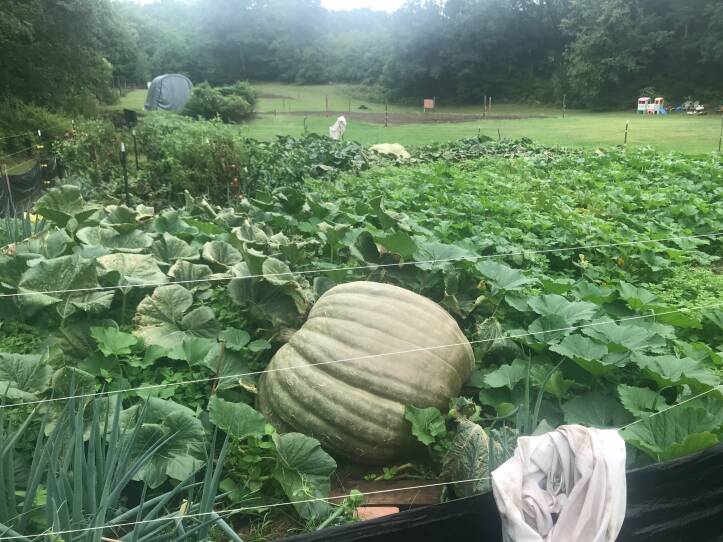Some half a million people are expected to descend on the town of Topsfield, Mass. between September 28 and October 8 for this year's Topsfield Fair. The fair, often billed as the oldest agricultural fair in the country, celebrates it's 200th anniversary this year.
I got to wondering what the folks at the Essex Agricultural Society had in store to mark the occasion, so I headed up to Topsfield to find out.
Setup was in full swing as I walked the historic fairgrounds with Alexandra Pecci, whose book Two Hundred Years of the Topsfield Fair chronicles the venerable New England fair’s long history. She painted a picture for me of the scene soon expected here at the fairgrounds.
"Every part of the fairgrounds is packed when people are here," she said. "Corn dogs, fresh squeezed lemonade, right there they do giant turkey legs; tractor pulls and horse pulls, a lot of roosters, baby chickens; cattle and sheep and goat competitions. It smells like a good combination of a farm and a deep frying pit."
As we ambled along, Pecci told me about the fair through the years. The indian corn and barley competitions in the early days. A brief 19th century silk worm craze. Scrap metal or rubber got you in for free during World War Two. Dog racing was a thing for a while through the 1970s.
As we entered an empty barn, she explained that — these days — the fair’s centerpiece, perhaps its biggest draw, is the giant pumpkin weigh-off.
"In two weeks this will be filled up with fruits and vegetables and this is where the giant pumpkin will live," she said, pointing to a big, Plexiglas, climate-controlled display case. "The weigh-off kicks off the fair on Friday night and you will see people just lined up to take their picture with the giant pumpkin."
About 100 miles to the south, in Situate, Rhode Island, is where I met Joe Jutras — a man who grows some of the biggest gourds the word has ever seen.
"Topsfield, I would say, is probably the biggest deal to win," he said as we walked his property that includes three sizable garden plots, an enormous trellis for growing long gourds, and some 40 fruit trees. "It’s a great place to go. It’s very competitive. I’ve won it — in 2007."
By “won it,” Jutras means he set a then world record there with a 1,689 pound pumpkin.
"You have to have good seed, good soil, and good luck," he explained.
Sure. That is true. But when you are aiming to take a prize in the 21st century at a place like Topsfield, there's a little more to it.
"If you’re growing five or six plants and you’re not spending five or six hours out here, you’re falling behind," he said. Five or six hours a day? "A day," he clarified.
While these giant fruits – yes a pumpkin is a fruit – are only on the ground from April until October, the work begins years in advance.

Jutras is already prepping next year’s plot with rounds of mustard plants and plastic to detoxify and solarize the soil.
"It’s very important when you’re growing these you know the mother the father, the grandfather the grandmother," said Joutras. When I pointed out that he sounded like a horse breeder, he responded, "There’s no doubt about it. When you wanna grow the biggest fruit, you can you got to know the genetics."
That means not only choosing your seed carefully, but also playing honeybee — hand-pollinating a carefully selected male and female flower.
Soil upkeep for Jutras includes compost made with seaweed he hand-harvests from the Rhode Island coast and a concoction he makes from, well, worm droppings. Then you have to keep the main stem from snapping, fend of diseases, keep the fruit from collapsing, and tend to 1,000 huge photosynthesizing leaves.
Jutras says if you can get half of what you plant to the scale, you’ve had a good year. Last year, he had a great year — setting a new world record for green squash, basically a green pumpkin, at 2,118 pounds. For the record that is roughly the same weight as the 2007 Toyota Yaris that I drove down to Jutras' place.
What happens when you grow a world record [is] you’ve got all the clubs — all over the world, all over the country — ask for seeds for donations for fundraisers for their clubs," he said.
There’s a good chance the next world record will come from one of the 200-plus seeds he gave away. And that sharing is the point. Jutras says each new world record is a win for the entire giant fruit growing community.
And that sharing among growers is something Pecci says has been a crucial part of Topsfield from the outset. And it appears that — 200 years on — that's still what it's all about. Well, that and — ya know — fried dough and giant caramel apples.





